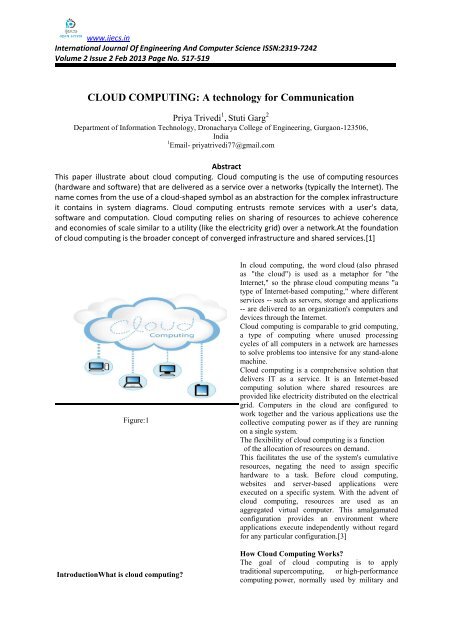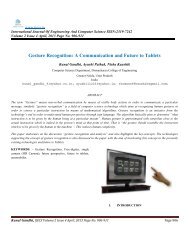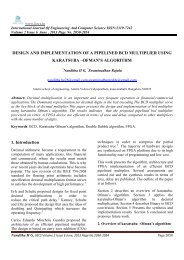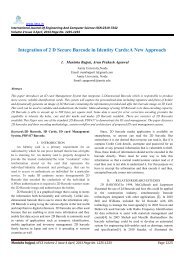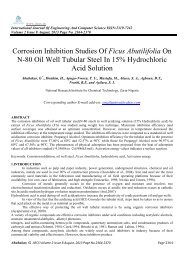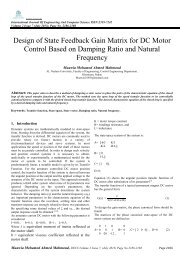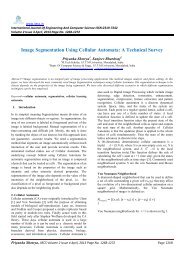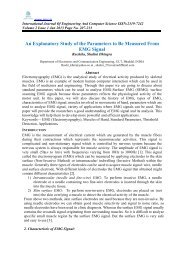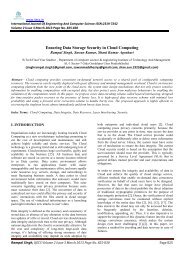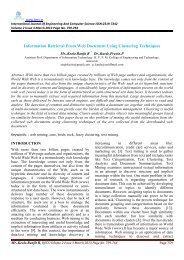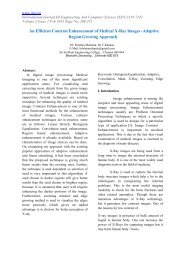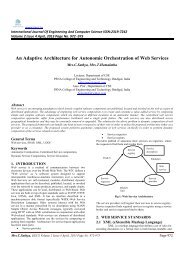CLOUD COMPUTING: A technology for Communication - Ijecs
CLOUD COMPUTING: A technology for Communication - Ijecs
CLOUD COMPUTING: A technology for Communication - Ijecs
Create successful ePaper yourself
Turn your PDF publications into a flip-book with our unique Google optimized e-Paper software.
www.ijecs.inInternational Journal Of Engineering And Computer Science ISSN:2319-7242Volume 2 Issue 2 Feb 2013 Page No. 517-519<strong>CLOUD</strong> <strong>COMPUTING</strong>: A <strong>technology</strong> <strong>for</strong> <strong>Communication</strong>Priya Trivedi 1 , Stuti Garg 2Department of In<strong>for</strong>mation Technology, Dronacharya College of Engineering, Gurgaon-123506,India1 Email- priyatrivedi77@gmail.comAbstractThis paper illustrate about cloud computing. Cloud computing is the use of computing resources(hardware and software) that are delivered as a service over a networks (typically the Internet). Thename comes from the use of a cloud-shaped symbol as an abstraction <strong>for</strong> the complex infrastructureit contains in system diagrams. Cloud computing entrusts remote services with a user's data,software and computation. Cloud computing relies on sharing of resources to achieve coherenceand economies of scale similar to a utility (like the electricity grid) over a network.At the foundationof cloud computing is the broader concept of converged infrastructure and shared services.[1]Figure:1IntroductionWhat is cloud computing?In cloud computing, the word cloud (also phrasedas "the cloud") is used as a metaphor <strong>for</strong> "theInternet," so the phrase cloud computing means "atype of Internet-based computing," where differentservices -- such as servers, storage and applications-- are delivered to an organization's computers anddevices through the Internet.Cloud computing is comparable to grid computing,a type of computing where unused processingcycles of all computers in a network are harnessesto solve problems too intensive <strong>for</strong> any stand-alonemachine.Cloud computing is a comprehensive solution thatdelivers IT as a service. It is an Internet-basedcomputing solution where shared resources areprovided like electricity distributed on the electricalgrid. Computers in the cloud are configured towork together and the various applications use thecollective computing power as if they are runningon a single system.The flexibility of cloud computing is a functionof the allocation of resources on demand.This facilitates the use of the system's cumulativeresources, negating the need to assign specifichardware to a task. Be<strong>for</strong>e cloud computing,websites and server-based applications wereexecuted on a specific system. With the advent ofcloud computing, resources are used as anaggregated virtual computer. This amalgamatedconfiguration provides an environment whereapplications execute independently without regard<strong>for</strong> any particular configuration.[3]How Cloud Computing Works?The goal of cloud computing is to applytraditional supercomputing, or high-per<strong>for</strong>mancecomputing power, normally used by military and
Page518Priya Trivedi International Journal Of Engineering And Computer Science 2:2 Feb 2013(517-519)research facilities, to per<strong>for</strong>m tens of trillions ofcomputations per second, in consumer-orientedapplications such as financial portfolios, to deliverpersonalized in<strong>for</strong>mation, to provide data storageor to power large, immersive computer games.initiated a new product development ef<strong>for</strong>t toprovide cloud computing to external customers,and launched Amazon Web Service (AWS) on autility computing basis in 2006.[4][5]Characteristics• Cost is claimed to be reduced• Reliability is improved if multipleredundant sites are used, which makeswell-designed cloud computing suitable<strong>for</strong> business continuity and disasterrecoveryFigure:2To do this, cloud computing uses networks of largegroups of servers typically running low-costconsumer PC <strong>technology</strong> with specializedconnections to spread data-processing choresacross them. This shared IT infrastructure containslarge pools of systems that are linked together.Often, virtualization techniques are used tomaximize the power of cloud computing.Cloud Computing StandardsThe standards <strong>for</strong> connecting the computer systemsand the software needed to make cloud computingwork are not fully defined at present time, leavingmany companies to define their own cloudcomputing technologies. Cloud computing systemsoffered by companies, like IBM's "Blue Cloud"technologies <strong>for</strong> example, are based on openstandards and open source software which linktogether computers that are used to to deliver Web2.0capabilitieslike mash-ups or mobilecommerce.[2]• Per<strong>for</strong>mance is monitored, and consistentand loosely coupled architectures areconstructed using web services as thesystem interface. [28]• Security could improve due tocentralization of data, increased securityfocusedresources, etc.• Maintenance of cloud computingapplications is easier, because they do notneed to be installed on each user'scomputer and can be accessed fromdifferent places.• Virtualization <strong>technology</strong> allows serversand storage devices to be shared andutilization be increased. Applications canbe easily migrated from one physicalserver to another.• Agility improves with users' ability to reprovisiontechnological infrastructureresources.[5]HistoryThe origin of the term cloud computing is obscure,but it appears to derive from the practice of usingdrawings of stylized clouds to denote networks indiagrams of computing and communicationssystems. The word cloud is used as a metaphor <strong>for</strong>the Internet, based on the standardized use of acloud-like shape to denote a networkAmazon played a key role in the development ofcloud computing by modernizing their data centers,which, like most computer networks, were using aslittle as 10% of their capacity at any one time, justto leave room <strong>for</strong> occasional spikes. AmazonArchitecture• The Cloud Computing Architecture of a cloudsolution is the structure of the system, whichcomprises of on-premise and cloud resources,services, middleware, and softwarecomponents, their geo-location, theirexternally visible properties and therelationships between them.• Cloud architecture typically involves multiplecloud components communicating with eachother over a loose coupling mechanism suchas a messaging queue. Elastic provisioningimplies intelligence in the use of tight or
Page519Priya Trivedi International Journal Of Engineering And Computer Science 2:2 Feb 2013(517-519)loose coupling of cloud resources,services, middleware, and softwarecomponents.• In the area of cloud computing, protectiondepends on having the right architecture <strong>for</strong>the right application. Organizations mustunderstand the individual requirements oftheir applications, and if already using a cloudplat<strong>for</strong>m, understand the corresponding cloudarchitecture.• A cloud computing architecture consists of afront end and a back end. They connect toeach other through a network, usually theInternet. The front end is the side thecomputer user, or client, sees. The back end isthe “cloud” section of the system[5][3]Retrievedfromhttp://thecustomizewindows.com/2012/12/what-is-cloudcomputing/?gclid=CNHVke_RvLUCFVEU6wod9EYATA[4]Retreived from http://www.us-cert.gov/reading_room/USCERT-CloudComputingHuthCebula.pdf[5]Retrievedfromhttp://en.wikipedia.org/wiki/Cloud_computingFigure: 3ConclusionIn this revolutionary new era, cloud computing canprovide organizations with the means and methodsneeded to ensure financial stability and high qualityservice. Of course, there must be globalcooperation if the cloud computing process is toattain optimal security and general operationalstandards. With the advent of cloud computing it isimperative <strong>for</strong> us all to be ready <strong>for</strong> the revolution.References[1] <strong>CLOUD</strong> <strong>COMPUTING</strong> (Internet Sources:Wikipedia; Network world; Webopedia)[2]Retrievedfromhttp://www.webopedia.com/TERM/C/cloud_computing.html


